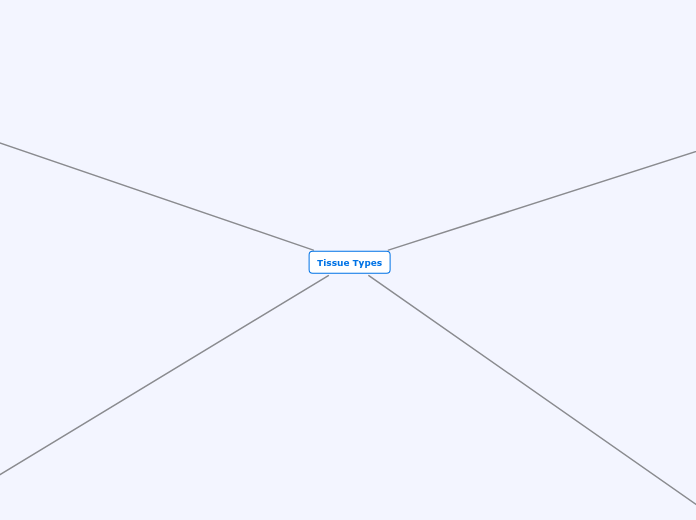Tissue Types
Epithelial

Simple Squamous
Appearance: Flat and Thin
Function: Diffusion and Filtration
Location: Air Sacs in Lungs, Capillaries
Appearance: Cubed Shaped
Function: Secretion and Absorption
Location: Kidneys, Tubules, Ducts, Ovaries

Simple Columnar
Appearance: Column Shaped
Function: Secretion and Absorption
Location: Digestive Tract and Uterus

Stratified Squamous
Appearance: Tall and Flattened
Function: Protection
Location: Skin and Mouth

Pseudostratified Columnar
Appearance: Stratified Single Layer
Function: Secretion and Cilia-aided Movement
Location: Air passages and Reproductive Tubes

Transitional Epithelium
Appearance: Stretchable
Function: Blocks Diffusion
Location: Urinary Bladder

Glandular Epithelium
Appearance: Stratified with Goblet Cells
Function: Secretion
Endocrine and Exocrine Glands

Stratified Cuboidal
Appearance: Multiple Layers of Cubes
Function: Secretion and Protection
Location: Pancreatic Ducts and Salivary Glands

Stratified Columnar
Appearance: Column Shaped in Multiple Layers
Function: Protection and Secretion
Location: Parts of the Eye, Pharynx, Anus, Uterus, Male Urethra, and Vas Deferens
Connective

Loose Connective or Areolar Tissue
Appearance: Loose arrangement of collagenous and elastic fibers, scattered cells of various types; abundant ground substance; numerous blood vessels
Function: Binds underlying organs to skin and to each other and also forms delicate thin membranes throughout the body.
Location: Skin, around mucous membranes, around blood vessels, nerves, and organs of the body.

Adipose
Appearance: Loose connective tissue composed of adipocytes.
Function: Serves as a protective cushion, insulation to preserve body heat, and stores energy.
Location: Subcutaneous fat, visceral fat, bone marrow, and breasts.

Fibrous
Appearance: Large amounts of collagen fibers and few cells or matrix material.
Function: Support
Location: Dermis of skin, tendons, and ligaments.

Hyaline Cartilage
Appearance: Glass-like but translucent with a pearl-grey color and a considerable amount of collagen with a firm consistency.
Function: Shock absorber and reduces friction by serving as a padding between bones where they meet at joints.
Location: Ends of joints, nose and respiratory passages.

Elastic Cartilage
Appearance: Contains many yellow elastic fibers with chondrocytes that lie between them that appear dark.
Function: Greatly flexible to efficiently channel sound waves to the inner ear.
Location: External Ear and Larynx.

Fibrocartilage
Appearance: Tough, dense, and fibrous material.
Function: Shock absorber
Location: Between Vertebrae

Blood Tissue
Appearance: Contains a fluid matrix and no fibers.
Function: Transports Oxygen and Carbon Dioxide.
Location: Around every blood vessel.

Bone Tissue
Appearance: Concentric rings of matrix that surround central canals that contain blood vessels that inside contain lacunae that are connected to each other through canalicula.
Function: Locomotion, support and protection of soft tissues, calcium and phosphate storage, and harboring of bone marrow.
Location: Throughout the body.
Muscle

Smooth Muscle
Appearance: Contains small smooth muscle cells that our spindle shaped and have no striations but have bundles of thin and thick filaments.
Function: Controls involuntary movements.
Location: In the walls of hollow visceral organs.

Cardiac Muscle
Appearance: Contains bundles that are branched like a tree but is connected at both ends.
Function: Controls the contraction and relaxation of the heart.
Location: Walls of the heart.

Skeletal Muscle
Appearance: Is striated and conatins long, thin, multi nucleated fibres that are crossed with a regular pattern of fine red and white lines.
Function: Moves the body.
Location: Attached to the Skeleton.

Nervous (Spinal Cord)
Appearance: Consists of neurons, dendrites, and axons that form a long line of connectivity.
Function: Receives stimuli and sends impulses to the spinal cord and Brain.
Location: In peripheral nerves and in organs of the central nervous system, brain, and spinal cord.
